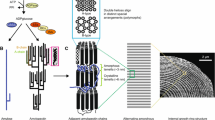Abstract
Solanum tuberosum L. Gp. Tuberosum populations that had been improved for resistance to potato leafhopper,Empoasca fabae (Harris), by recurrent selection, were analyzed for tuber contents of the glycoalkaloids α-solanine and α-chaconine. The mean content of both glycoalkaloids was significantly higher in the more resistant populations compared with the unselected population. In a population generated from seven cycles of selection for resistance, the mean content of solanine + chaconine was 9.5 mg/100 g fresh weight compared with 4.0 mg/100 g in the original, unselected population; a 137% increase. Kennebec, in the same experiment, averaged 10.9 mg/100 g; Katahdin averaged 4.6 mg/100 g.
Compendio
Poblaciones deSolanum tuberosum L. Gp. mejoradas por selectión recurrente para la resistencia a la cigarrita de la papaEmpoasca fabae (Harris), fueron analizadas para determinar el contenido en los tubérculos de los glicoalcaloides α-solanina y α-chaconina. El contenido promedio de ambos glicoalcaloides fue significativamente mayor en las poblaciones más resistentes comparado con el de las poblaciones no seleccionadas. En una población generada a partir de siete ciclos de selección para la resistencia, el contenido promedio de solanina más chaconina fue de 9,5 mg/100 g de peso fresco, comparado con 4,0 mg/100 g en la población original no seleccionada, es ducir un incremento de 137%. El contenido promedio de solanina más chaconina de la variedad Kennebec, en el mismo experimento, fue de 10.9 mg/100 g y el de Katahdin fue de 4.6 mg/100 g.
Similar content being viewed by others
Literature Cited
Allen, T.C. and G.H. Rieman. 1939. Occurrence of hopperburn resistance and susceptibility in the potato. Am Potato J 16:130–142.
Borner, R. and H. Mattis. 1924. [The solanine content of potatoes]. Z Unters Nahr-Genussm 47:97–127.
Bushway, R.J., J.L. Bureau and J. King. 1986. Modification of the rapid highperformance liquid Chromatographic method for the determination of potato glycoalkaloids. J Agric Food Chem 34:277–279.
Carman Jr, A.S., S.S. Kuan, G.M. Ware, O.J. Francis, Jr. and G.P. Kirschenheuter. 1986. Rapid high-performance liquid Chromatographic determination of the potato glycoalkaloids α-solanine and α-chaconine. J Agric Food Chem 34:279–282.
Dahlman, D.L. and E.T. Hibbs. 1967. Responses ofEmpoasca fabae (Cicadellidae: Homoptera) to tomatine, solanine, leptine I; Tomatidine, solanidine, and demissidine. Ann Entomol Soc Am 60:732–740.
Deahl, K.L., R.S. Young and S.L. Sinden. 1973. A study of the relationship of late blight resistance to glycoalkaloid content of fifteen potato clones. Am Potato J 50:248–253.
Morris, S.C. and T.H. Lee. 1981. Analysis of potato glycoalkaloids with radially compressed high-performance liquid Chromatographie cartridges and ethanolamine in the mobile phase. J Chromatography 219:403–410.
Petroshenko, E.I. 1956. [Glycoalkaloids in crop plants]. Usp Sovrem Biol 42:19–32.
Raman, K.V., W.M. Tingey and P. Gregory. 1979. Potato glycoalkaloids: Effect on survival and feeding behavior of the potato leafhopper. J Econ Entomol 72:337–341.
Sanford, L.L. 1979. Effect of random mating on yield and specific gravity in twoSolatium tuberosum subsp.tuberosum populations. Am Potato J 56:597–607.
Sanford, L.L. 1982. Effect of plant age on potato leafhopper infestation of resistant and susceptible potato clones. Am Potato J 59:9–16.
Sanford, L.L. and J.P. Sleesman. 1974. Selection for resistance to potato leafhopper in potatoes. I. Selection methods. Am Potato J 51:44–49.
Sanford, L.L. and T.L. Ladd. 1983. Selection of resistance to potato leafhopper in potatoes. III. Comparison of two selection procedures. Am Potato J 60:653–659.
Sanford, L.L. and T.L. Ladd, Jr. 1987. Recurrent selection for potato leafhopper resistance in potato,Solanum tuberosum L. Gp. Tuberosum. Am Potato J 64:367–375.
Sanford, L.L. and S.L. Sinden. 1972. Inheritance of potato glycoalkaloids. Am Potato J 49:209–217.
Sanford, L.L., K.L. Deahl, S.L. Sinden and T.L. Ladd, Jr. 1990. Foliar solanidine glycoside levels inSolanum tuberosum populations selected for potato leafhopper resistance. Am Potato J 67:461–466.
SAS/STAT Guide, Version 6. 1987. SAS Institute Inc., Cary, N.C.
Schwarze, P. 1962. [Methods for identification and determination of solanine in potato breeding material]. Züchter 32:155–160.
Schwarze, P. 1963. [The content and composition of the glycoalkaloid complex in progenies of the interspecific crossS. tuberosum ×S. chacoense] Züchter 33:275–281.
Sinden, S.L. and R.W. Webb. 1974. Effect of environment on glycoalkaloid content of six potato varieties at 39 locations. U.S. Dept Agric Tech Bull 1472.
Sinden, S.L., L.L. Sanford and R.E. Webb. 1984. Genetic and environmental control of potato glycoalkaloids. Am Potato J 61:141–156.
Sinden, S.L, L.L. Sanford and K.L. Deahl. 1986. Segregation of leptine glycoalkaloids inSolanum chacoense Bitter. J Agric Food Chem 34:372–377.
Sleesman, J.P. and F.J. Stevenson. 1941. Breeding a potato resistant to the potato leafhopper. Am Potato J 18:279–298.
Tingey, W.M., J.D. Mackenzie and P. Gregory. 1978. Total foliar glycoalkaloids and resistance of wild potato species toEmpoasca fibae (Harris). Am Potato J 55:577–585.
Van de Klashorst, G. and W.M. Tingey. 1979. Effect of seedling age, environmental temperature, and foliar total glycoalkaloids on resistance of fiveSolanum genotypes to the potato leafhopper. Environ Entomol 8:690–693.
Wolf, M.S. and B.M. Dugger. 1946. Estimation and physiological role of solanine in the potato. J Agric Res 73:1–32.
Author information
Authors and Affiliations
Rights and permissions
About this article
Cite this article
Sanford, L.L., Deahl, K.L., Sinden, S.L. et al. Glycoalkaloid contents in tubers fromSolanum tuberosum populations selected for potato leafhopper resistance. American Potato Journal 69, 693–703 (1992). https://doi.org/10.1007/BF02853813
Accepted:
Issue Date:
DOI: https://doi.org/10.1007/BF02853813




